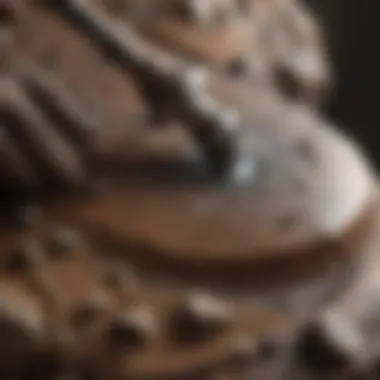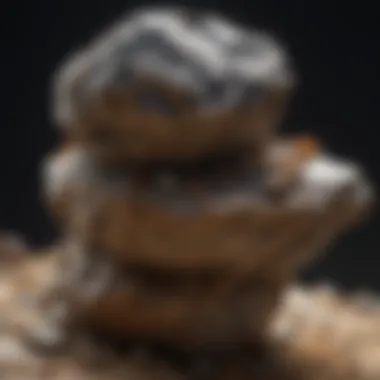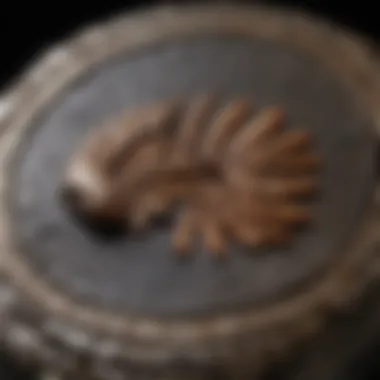Unlocking the Potential: Dremel Tool's Role in Rock and Fossil Collection Exposed


Rock and Fossil Identification
In the fascinating realm of rock and fossil collection, understanding the types of rocks and fossils is paramount. Rocks can range from igneous, sedimentary, to metamorphic, each with distinct characteristics that offer clues to their formation processes and geological history. On the other hand, fossils come in various forms, including molds, casts, imprints, and petrified remains, providing insights into past life forms and ecosystems. To identify these geological treasures accurately, collectors must pay attention to specific characteristics such as color, texture, hardness, and any visible markings unique to each specimen. Utilizing specialized tools like magnifying glasses, hardness picks, and UV lights can aid in the identification process, enabling enthusiasts to distinguish between different rock types and fossil varieties with precision.
Collecting Tips and Techniques
For aspiring rock and fossil collectors, adopting best practices is crucial for a successful and fulfilling experience. When embarking on collecting expeditions, it is essential to research and identify prime collecting sites that are legally accessible and offer diverse geological specimens. Taking precautionary measures by wearing appropriate safety gear, such as gloves and eye protection, is imperative when handling tools and extracting specimens from excavation sites. To extract specimens safely and preserve their integrity, employing techniques like chiseling, brushing, and using rock hammers can prevent damage while excavating delicate specimens. Additionally, documenting the collection process through photography and detailed notes provides a valuable record of where and how specimens were found, enhancing the overall collecting experience.
Preservation and Display
Preserving rocks and fossils is essential to maintain their condition and integrity for future generations to appreciate. Implementing effective techniques such as cleaning with gentle brushes and mild detergents, as well as using consolidants to stabilize fragile specimens, can prolong their lifespan and prevent deterioration. Proper storage methods, such as acid-free containers and padded display cases, protect specimens from environmental factors like moisture and sunlight, ensuring their longevity. When it comes to creative display ideas, showcasing specimens in themed arrangements or designing custom mounts can enhance their aesthetic appeal and educational value, creating captivating displays that engage viewers and spark curiosity about geology and paleontology.
Geological Insights
Delving into the geological aspects of rock and fossil collection unveils a world of fascinating discoveries and insights. By studying geological formations and processes that shaped the Earth's landscape over millions of years, collectors gain a deeper appreciation for the forces that have shaped our planet. Exploring the historical significance of rocks and fossils offers a glimpse into the evolution of life on Earth and the environmental changes that have occurred throughout geological time. Furthermore, learning about notable discoveries in the field of geology and paleontology sheds light on groundbreaking findings that have advanced our understanding of prehistoric life forms and ancient environments, highlighting the importance of continued exploration and research in these disciplines.
Introduction
In the vast expanse of rock and fossil collection, the utilization of the Dremel tool stands as a beacon of innovation and precision. This introductory section sets the stage for a detailed exploration of how this versatile tool revolutionizes the art of rock and fossil manipulation.
Understanding the Significance of Dremel Tool
History of Dremel Tool
The history of the Dremel tool traces back to its inception, highlighting its evolution as a cornerstone in the realm of craftsmanship. The key characteristic of the Dremel tool's history lies in its continuous enhancements, catering to the ever-evolving needs of professionals and enthusiasts alike. This rich history ensures that the Dremel tool remains a top choice for rock and fossil collectors, offering reliability and efficiency. The unique feature of the Dremel tool's history is its seamless integration of cutting-edge technology with user-friendly design, providing a seamless experience for users.
Evolution in Rock and Fossil Collection
The evolution of rock and fossil collection has been significantly impacted by the introduction of the Dremel tool. With its unparalleled versatility and precision, the Dremel tool has become a mainstay in enhancing the intricacy and quality of geological specimens. The key characteristic of this evolution lies in its ability to elevate the art of rock and fossil manipulation to new heights, revolutionizing traditional techniques. The Dremel tool's unique feature in this evolution is its adaptability to various substrates and textures, offering a range of advantages in terms of detailing and customization.


Overview of Rock and Fossil Collection
Importance of Precision
Precision plays a vital role in the realm of rock and fossil collection, emphasizing the need for meticulous detailing and accuracy. The key characteristic of precision lies in its ability to capture the intricate beauty of geological specimens with unparalleled clarity. This precision is a popular choice among rock and fossil collectors for its ability to showcase the unique features of each specimen, enhancing their overall aesthetic appeal. However, the precision also comes with its set of challenges, requiring steady hands and careful maneuvering to achieve desired outcomes.
Challenges in Detailing
Detailing in rock and fossil collection presents a unique set of challenges that enthusiasts must navigate. The key characteristic of these challenges is the delicate balance between revealing the true essence of a specimen while preserving its integrity. This intricate process is a beneficial choice for collectors looking to add depth and authenticity to their collections. However, the challenges in detailing also come with potential disadvantages, such as the risk of overworking a specimen or compromising its natural form. It is essential for enthusiasts to approach detailing with caution and precision to ensure optimal results.
Utilizing Dremel Tool for Rock Collection
In this section, we will delve into the significance of utilizing the Dremel tool for rock collection. The importance of this topic lies in its ability to enhance the precision and intricacy involved in rock detailing, shaping, and polishing. Utilizing the Dremel tool offers rock and fossil enthusiasts a level of control and finesse that is unparalleled. By incorporating this versatile tool into their collection process, individuals can elevate the quality and authenticity of their geological specimens. The benefits of using the Dremel tool for rock collection extend to the ability to create intricate designs and achieve smooth finishes, adding value to the overall collection.
Shaping Techniques
Carving
Carving plays a pivotal role in the realm of rock collection by allowing enthusiasts to sculpt and shape various geological specimens with precision. The key characteristic of carving with a Dremel tool lies in its ability to intricately carve out details and create depth in the rocks, enhancing their visual appeal. One of the significant advantages of carving is the level of control it provides over the shaping process, ensuring that specific designs and patterns are executed with finesse. While carving can be time-consuming for intricate designs, the end result justifies the effort, offering collectors uniquely crafted rock specimens.
Sanding
Sanding is another essential shaping technique that contributes to the overall refinement of geological specimens. The primary characteristic of sanding with a Dremel tool is its ability to smooth out rough surfaces and achieve uniformity in texture. Sanding proves to be a popular choice for rock collectors due to its efficiency in removing imperfections and creating a flawless finish. However, one must be cautious with the sanding process to avoid over-smoothing or altering the natural characteristics of the rocks, thus balancing the precision and finesse required in rock detailing.
Polishing Methods
Buffing
Buffing serves as a fundamental polishing method for rock collectors seeking to enhance the luster and shine of their specimens. The key characteristic of buffing lies in its capacity to bring out the natural beauty of geological materials by smoothing out uneven surfaces and restoring the sheen. Buffing is a beneficial choice for this article as it allows collectors to achieve a professional finish and highlight the unique characteristics of each rock. However, caution must be exercised during the buffing process to prevent overheating or damaging the rocks, maintaining their integrity and enhancing their visual appeal.
Grinding


Grinding plays a significant role in the polishing process by refining rough surfaces and achieving specific shapes or angles on geological specimens. The key characteristic of grinding with a Dremel tool is its precision in removing excess material and reshaping rocks according to the desired specifications. Grinding is a popular choice among rock collectors due to its versatility in delivering both subtle modifications and dramatic transformations to the specimens. While grinding offers efficiency in polishing, collectors must ensure proper technique and control to avoid altering the natural features of the rocks, thus striking a balance between precision and preservation.
Detailing and Engraving
Intricate Designs
Intricate designs represent a creative aspect of rock detailing that allows collectors to add personalized touches and intricate patterns to their specimens. The key characteristic of intricate designs with a Dremel tool is the level of detailing and precision it offers, enabling collectors to showcase intricate patterns and textures on the rocks. The benefits of intricate designs lie in the ability to customize each geological specimen uniquely, adding artistic value and personalization to the collection. However, achieving intricate designs requires patience and skill, as meticulous attention to detail is essential to bring out the desired intricacies without compromising the integrity of the rocks.
Personalization
Personalization adds a unique touch to rock and fossil collections, allowing enthusiasts to engrave initials, messages, or symbols that hold personal significance on the specimens. The key characteristic of personalization with a Dremel tool is the opportunity it provides for collectors to infuse their personality and memories into the geological specimens. Personalization proves to be a popular choice for this article as it adds emotional value and sentimental meaning to the collection, making each rock a treasured and personalized artifact. However, careful consideration must be given to the placement and depth of engraving to ensure that the rocks’ natural beauty is preserved while incorporating personalized elements effectively.
Enhancing Fossil Presentation with Dremel Tool
Enhancing the presentation of fossils with a Dremel tool is a meticulous process that can bring out the true beauty and authenticity of these ancient artifacts. By employing the right techniques and approaches, collectors can elevate the visual appeal of their fossil displays to an unparalleled level of precision and detail. This section will delve into the significance of utilizing the Dremel tool for fossil enhancement, highlighting key methods and considerations to help enthusiasts enhance their collections with finesse.
Cleaning and Preparation
Removal of Debris
When it comes to preparing fossils for display, removing debris is a crucial step that demands precision and care. The meticulous removal of dirt, rocks, and other unwanted materials from the surface of a fossil is essential to reveal its true beauty and intricate details. Utilizing the Dremel tool for debris removal allows collectors to gently clean each crevice and contour of the fossil, unveiling hidden features while preserving its integrity. While this process may be time-consuming, the results speak for themselves, showcasing the fossil in its purest form.
Surface Smoothing
Surface smoothing plays a vital role in enhancing the aesthetics of a fossil, ensuring that its surface is free from imperfections and rough edges. By employing the Dremel tool for surface smoothing, collectors can achieve a polished and professional finish that accentuates the fossil's unique characteristics. This technique involves delicately sanding and refining the surface of the fossil to achieve a seamless texture that highlights its intricate patterns and structures. With precision and attention to detail, surface smoothing with a Dremel tool can transform a fossil into a masterpiece of natural history.
Restoration Techniques
Preserving Authenticity
Preserving the authenticity of fossils is a paramount concern for collectors seeking to uphold the integrity and historical value of these artifacts. Utilizing the Dremel tool to preserve authenticity involves delicate methods that focus on maintaining the fossil's original features while enhancing its visual appeal. By carefully cleaning, repairing, and protecting the fossil with precision tools and techniques, collectors can ensure that its authenticity remains intact, reflecting its true historical significance.


Reconstructing Fragments
In some cases, fossils may undergo fragmentation or damage over time, requiring meticulous reconstruction to restore their original form and structure. The Dremel tool offers collectors the precision and control needed to reconstruct fragments with accuracy and detail. By carefully piecing together broken sections, smoothing rough edges, and blending materials seamlessly, collectors can breathe new life into damaged fossils, showcasing their beauty and resilience.
Display Customization
Mounting Options
Choosing the appropriate mounting options for fossil displays is essential to highlight the uniqueness and beauty of each specimen. The Dremel tool provides collectors with the flexibility to explore various mounting techniques, from traditional stands to custom-made displays. By incorporating innovative mounting options, collectors can showcase their fossils in a visually striking manner that captures the attention of viewers and underscores the significance of each artifact in their collection.
Labeling and Identification
Effective labeling and identification play a crucial role in educating viewers about the significance and origins of fossils on display. Utilizing the Dremel tool for labeling allows collectors to engrave informative details directly onto the mounting materials, ensuring that viewers can easily identify and appreciate each fossil. By adding unique labels, descriptions, and information, collectors can create a cohesive and informative display that enhances the overall viewing experience, making their fossil collection more engaging and educational.
Safety Measures and Maintenance
In the domain of rock and fossil collection, emphasizing safety measures and maintenance is paramount to ensure the longevity of equipment and the well-being of enthusiasts. Carving out an efficient strategy for protective gear and tool upkeep not only safeguards against potential hazards but also prolongs the lifespan of your trusted Dremel tool. With a focus on prevention rather than reaction, collectors can delve into their passion with peace of mind, knowing that they are adequately prepared for any situation.
Protective Gear
Eye Protection
When it comes to eye protection in the context of rock and fossil collection, nothing can be left to chance. Shielding your eyes from dust, debris, and potential splinters is essential to prevent any unforeseen injuries during intricate detailing or shaping processes. Opting for high-quality, impact-resistant goggles ensures clear vision without compromising on safety. The anti-fog coating also aids in maintaining visibility, which is crucial for precision work, especially crucial when operating a Dremel tool. While some may find goggles slightly uncomfortable, the benefits far outweigh any minor discomfort, making them a staple in any rock collector's toolkit.
Respiratory Safety
Respiratory safety is often an overlooked aspect but is equally crucial in the world of rock and fossil collection. The fine particles generated during sanding or grinding can pose a threat to your respiratory system, leading to potential health issues over time. Investing in a reliable respirator that filters out these harmful particles significantly reduces the risk of respiratory ailments. Additionally, ensuring proper ventilation in your workspace is a simple yet effective measure to enhance overall respiratory safety. While respirators may seem cumbersome to some, the long-term protection they offer makes them a non-negotiable accessory for any dedicated enthusiast.
Tool Maintenance
Cleaning and Lubrication
Maintaining your Dremel tool through regular cleaning and lubrication is key to ensuring its optimal performance and longevity. Thoroughly cleaning the components after each use prevents debris buildup, which can affect the tool's functionality and precision. Using the recommended lubricants on moving parts not only enhances efficiency but also reduces wear and tear, prolonging the tool's lifespan. Incorporating a cleaning and lubrication routine into your workflow may seem tedious initially, but the benefits in terms of durability and consistent performance make it a worthwhile endeavor for any serious collector.
Tip Replacement
Regularly replacing the tip of your Dremel tool is akin to giving it a new lease on life. As the tip wears down over time with usage, it impacts the tool's effectiveness in intricate detailing and precision work. Opting for high-quality replacement tips tailored to your specific needs ensures consistent performance and sharp detailing capabilities. While replacing tips may seem like a minor aspect, the difference it makes in the quality of your work is significant, making it a practice that should not be overlooked in the pursuit of perfection.







